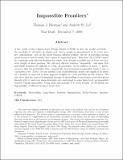Impossible Frontiers
Author(s)
Brennan, Thomas J.; Lo, Andrew W.
DownloadImpossible Frontiers.pdf (307.7Kb)
OPEN_ACCESS_POLICY
Open Access Policy
Creative Commons Attribution-Noncommercial-Share Alike
Terms of use
Metadata
Show full item recordAbstract
A key result of the capital asset pricing model (CAPM) is that the market portfolio—the portfolio of all assets in which each asset's weight is proportional to its total market capitalization—lies on the mean-variance-efficient frontier, the set of portfolios having mean-variance characteristics that cannot be improved upon. Therefore, the CAPM cannot be consistent with efficient frontiers for which every frontier portfolio has at least one negative weight or short position. We call such efficient frontiers “impossible,” and show that impossible frontiers are difficult to avoid. In particular, as the number of assets, n, grows, we prove that the probability that a generically chosen frontier is impossible tends to one at a geometric rate. In fact, for one natural class of distributions, nearly one-eighth of all assets on a frontier is expected to have negative weights for every portfolio on the frontier. We also show that the expected minimum amount of short selling across frontier portfolios grows linearly with n, and even when short sales are constrained to some finite level, an impossible frontier remains impossible. Using daily and monthly U.S. stock returns, we document the impossibility of efficient frontiers in the data.
Date issued
2010-06Department
Sloan School of ManagementJournal
Management Science
Publisher
Institute for Operations Research and the Management Sciences
Citation
Brennan, T. J., and A. W. Lo. “Impossible Frontiers.” Management Science 56 (2010): 905-923.
Version: Author's final manuscript
ISSN
1526-5501
0025-1909